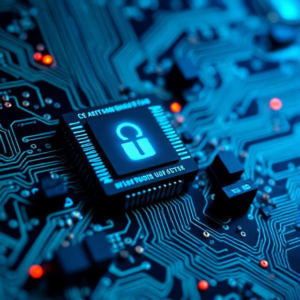Cybersecurity in embedded electronics is about protecting small, specialized computer systems (known as embedded systems) from cyberattacks and unauthorized access. Embedded systems are everywhere: in our smartphones, cars, medical devices, home appliances, and even industrial machinery. Since these systems are connected to the internet or other networks, they are vulnerable to hacking, malware, and other types of cyber threats.
1. What are Embedded Systems?
Embedded systems are computers designed to perform a specific function within a larger device or system. Unlike general-purpose computers, which can run many different programs, embedded systems usually run one specific program. Examples include:
- Smart thermostats controlling home temperature.
- Wearable fitness trackers monitoring your health.
- Automated industrial machines in factories.
- Cars with advanced driver assistance systems (ADAS).
These systems often have limited resources (such as processing power and memory), and they are often designed to be “always on,” meaning they need protection from potential security risks.

2. Why is Cybersecurity Important for Embedded Electronics?
Embedded systems are increasingly connected to the internet (the Internet of Things, or IoT), allowing them to communicate with other devices or networks. While this connectivity offers convenience, it also opens up the potential for cyberattacks. Without proper cybersecurity measures, hackers could:
- Steal sensitive data (like personal information from medical devices or smart home systems).
- Hijack control of the device, leading to unsafe or malicious actions (like controlling a car’s braking system).
- Cause damage or disrupt operations in critical systems, such as power grids or industrial machines.
Therefore, cybersecurity is crucial to keep embedded devices secure from potential threats.
3. Key Cybersecurity Challenges in Embedded Electronics:
A. Limited Resources:
- Embedded systems often have limited processing power, memory, and storage, which makes it harder to implement complex security features (like encryption or antivirus software).
- These systems might not have enough power to run heavy security algorithms, so efficient, lightweight security methods are needed.
B. Long Lifecycles:
- Embedded systems often have long lifecycles (sometimes lasting 10-20 years or more). During this time, the security threats can evolve, and the system might not be updated to protect against new vulnerabilities.
- Some embedded devices might not receive regular security patches or updates, making them vulnerable to newly discovered threats.
C. Limited User Interface:
- Many embedded systems don’t have screens or easy ways for users to interact with them (for example, a smart thermostat or industrial sensor might not have a display).
- This can make it harder for users to identify and respond to security issues, such as detecting if a device has been hacked.
D. Connectivity Issues:
- Many embedded systems are connected to the internet or local networks, which opens them up to cyberattacks. Poorly designed network security can leave devices exposed to attacks like man-in-the-middle attacks or denial-of-service (DoS) attacks.
4. Cybersecurity Techniques for Embedded Electronics:
A. Secure Boot:
- Secure boot ensures that the embedded system only loads software that is trusted and verified. When the system starts up, it checks the software to ensure it hasn’t been tampered with. If there’s any sign of corruption or unauthorized changes, the system will not boot, preventing malicious code from running.
B. Encryption:
- Encryption is used to protect data stored on the device or transmitted between devices. If an attacker intercepts the data, it would be unreadable without the decryption key. For example, medical devices can encrypt sensitive health data before sending it to the cloud or a healthcare server.
C. Authentication:
- Authentication is the process of verifying that a user or device is authorized to access the system. Common methods include passwords, PINs, and biometric identification (like fingerprints or facial recognition).
- For embedded systems, devices may use public key infrastructure (PKI), where the system verifies digital certificates to authenticate devices before allowing them to communicate.
D. Regular Software Updates:
- To prevent vulnerabilities, embedded systems need regular software updates to patch security holes. These updates can fix bugs and address newly discovered security issues.
- Secure over-the-air (OTA) updates are a common way to push updates to devices, especially for IoT devices.
E. Firewalls and Intrusion Detection:
- Embedded systems can have firewalls to block unauthorized incoming or outgoing network traffic.
- Intrusion detection systems (IDS) can monitor network traffic for signs of suspicious activity and raise alerts when potential threats are detected.
F. Sandboxing:
- Sandboxing is a technique that isolates parts of the system to limit the damage caused by a breach. For example, if malware infiltrates one part of the system, it can be confined to a “sandbox” so that it cannot affect the rest of the device or network.
G. Physical Security:
- Embedded devices can also benefit from physical security measures, such as tamper-resistant hardware or physical barriers that prevent attackers from accessing or altering the system’s internals.
- Some embedded devices include trusted platform modules (TPMs), which store encryption keys and other sensitive information in a secure, tamper-resistant chip.
5. Real-World Examples of Cybersecurity in Embedded Electronics:
- Medical Devices: Modern medical devices like pacemakers, insulin pumps, or remote monitoring systems can be vulnerable to attacks. Proper encryption and authentication ensure that patient data stays secure and that only authorized devices can communicate with these devices.
- Smart Home Devices: Devices like smart thermostats, security cameras, or smart locks need protection to prevent hackers from taking control of them. Secure communication protocols, regular software updates, and user authentication help protect these devices.
- Automotive Systems: Modern vehicles are full of embedded electronics, from driver assistance systems to infotainment systems. Ensuring the security of these systems is critical to prevent hackers from gaining control over vital systems like brakes or steering.
6. Conclusion:
Cybersecurity in embedded electronics is critical because these systems are often connected to the internet and perform essential tasks in our everyday lives. From encryption and secure booting to regular updates and authentication, there are many ways to protect these devices from cyber threats. As embedded systems continue to play a bigger role in everything from healthcare to transportation, ensuring they are secure becomes increasingly important to keep our data safe and our devices functioning properly.











